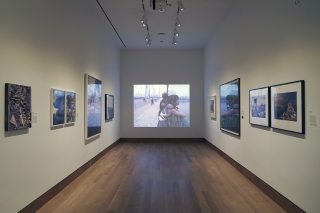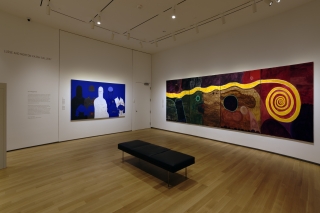Exhibitions Archive
Judy Crook 9
Jennifer SteinkampLocation: Top floor of the Hopkins Center
Judy Crook 9 is a digital animation painstakingly created by the artist Jennifer Steinkamp in 2017. Her work introduces images of nature into architectural spaces in a manner that complicates the idea of inside and outside, and built versus natural environments. Judy Crook 9 takes the viewer through four seasons in this one tree’s life—repeated endlessly to simultaneously evoke the cyclical nature of life and the ideal of infinite existence.
Steinkamp has been making works of digital art that honor her art teachers over the years. This work is from a series named after her professor of color theory at the Art Center College of Design, Pasadena. Rather than make one animation in an edition of nine, however, Steinkamp has made nine variations on the same theme—each one significantly different.
Contemporary Responses to Globalization
New LandscapesHumanity’s unceasing persistent consumption and development has had complex repercussions on the physical, social, and cultural landscapes around the world. Artists are actively engaging with the consequences of our impacts on the landscape and, in response, considering alternative realities—from imagining a transformed landscape or a dystopic future in the wake of ecological disaster to creating new worlds to escape the effects of industrialization. This exhibition of recent acquisitions reflects on the diversity of experiences in, responses to, and projections of our many lived and potential realities.
The Firmament
Toyin Ojih OdutolaLocation: Hood Downtown, 53 Main Street, Hanover, NH
Stories take center stage in Toyin Ojih Odutola’s drawings. She catches her characters at quiet moments captured from otherwise rich and complex lives. Short on specifics and long on allusion, the narratives she evokes suggest a wide emotional range. We are not meant to know exactly what takes place in these lives, but we are invited into their private spaces and we share an implied intimacy with many of them. Ojih Odutola allows us to peek, but not pry, into the lives of those who occupy her personal firmament. The artist establishes a compassionate confrontation between viewer and subject through the use of scale and through her extraordinary mark-making technique that draws us close to her surfaces. Many of the drawings are life-sized, some even full-length. This reinforces an uncanny sense that we share a space with her subjects; it also establishes an equivalence between viewer and subject.
Ojih Odutola’s signature drawing technique rewards close scrutiny. She creates small patches of color from carefully hatched lines to show skin; each plane works to delineate the exposed volumes of her sitter’s body. This technique is notably reserved for the depiction of skin; she draws clothes, furniture, and even the landscape in a looser, more broadly marked technique.
Past Forward
Sin-ying HoLocation: Hood Downtown, 53 Main Street, Hanover, NH
If Chinese ceramic art has a heart, it beats in Jingdezhen. For centuries, artisans there have made vessels that traveled far and wide. Their fluid forms and recognizable decorations have inspired celebratory prose and devoted followers around the world. Today, Sin-ying Ho works in these same ceramics factories. Though Jingdezhen potters have long defined tradition, Sin-ying has expanded both their forms and their imagery in contemporary ceramics that are thoroughly of the twenty-first century. She makes her works—whether they are monumental vases or smaller, more clearly assembled sculptures—from multiple parts. She emphasizes the many parts by glazing each of the pieces differently. Together they form a whole that maintains the legacy of being created from myriad fragments.
Sin-ying’s process of building is an essential metaphor for her artistic practice. With it, she implies an optimism for our society’s continued ability to construct a unified world. As reflected in her technique, and in the themes addressed by her surface imagery, this world will necessarily be an amalgam of new and old, here and there, greed and generosity, men and women, faith and despair. Through these combinations, Sin-ying shares a worldview that acknowledges the inherent contradictions and challenges of global culture while also anticipating the uncanny beauty emerging all around us.
Reason’s Oxymorons
Kader AttiaLocation: Hood Downtown, 53 Main Street, Hanover, NH
Reason’s Oxymorons, by internationally acclaimed artist Kader Attia, is a recent museum acquisition. The research-driven video installation, which will occupy the entire space at Hood Downtown in winter 2018, consists of a range of interviews by Attia with philosophers, psychiatrists, anthropologists, traditional healers, historians, musicologists, patients, and immigrants. The conversations are organized around several themes centered on the ways in which non-Western and Western cultures approach psychiatric conditions and emotional breakdowns. Composed of eighteen computer monitors, each set on a workman-like table in a secluded office cubicle with a chair, earphones, and loudspeakers, this ambitious installation evokes an ascetic modern office environment.






